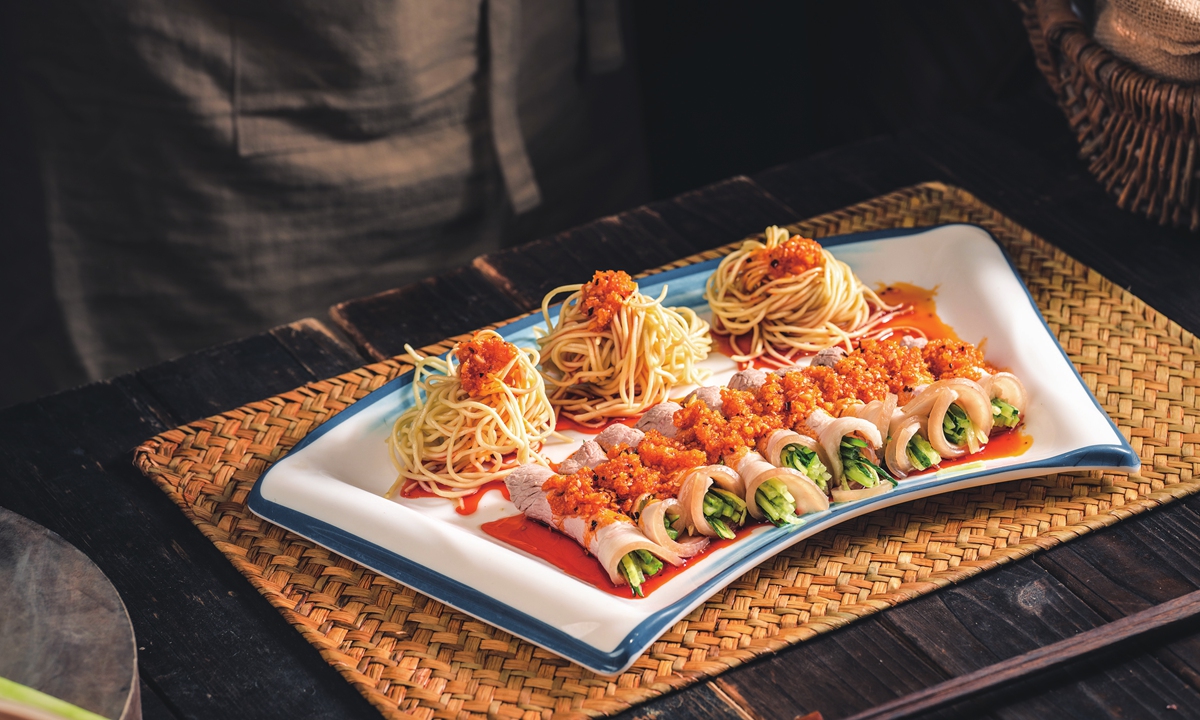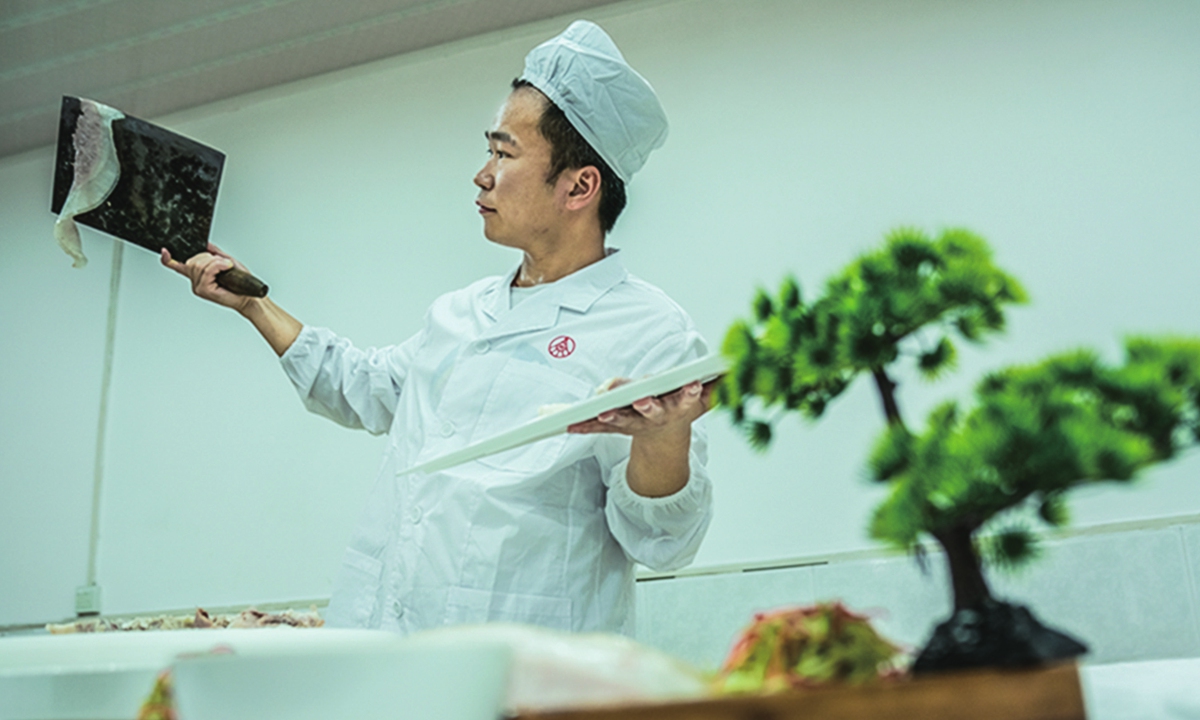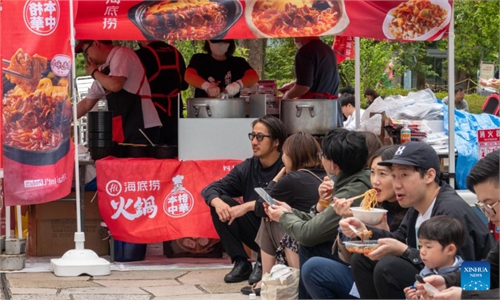ARTS / CULTURE & LEISURE
Two Sichuan-style restaurants earn Michelin recognition
Beijing’s hidden culinary gems shine

Sliced Pork Belly with Garlic Sauce, a local dish from Yibin, Sichuan Photo: VCG

A chef makes a Sliced Pork Belly with Garlic Sauce dish.Photo: VCG
In this month's highly-anticipated 2024 Beijing Michelin Guide release, two time-honored Sichuan-style restaurants have taken center stage. "Lao Chuan Ban" and "Yibin," both celebrated in the prestigious Michelin Bib Gourmand category, have emerged as culinary treasures of Beijing.
Unlike high-end, exclusive dining establishments, the restaurants have humble origins, evolved from the former government offices of Sichuan and Yibin in the capital. Known as "Zhu Jing Ban", meaning "local government's representative office in Beijing," the venues offer a unique dining experience deeply rooted in history.
These restaurants have become a culinary alternative in Beijing's diverse dining landscape, offering authentic, delectable and affordable cuisine. However, dining in these places comes with a caveat - reserving seats is often not an option, and enduring long waits in line is the norm. Despite this, the perpetual crowds and the enduring waits attest to the remarkable appeal of these establishments.
But what truly sets these restaurants apart is the incredible quality of their offerings. They provide a tantalizing array of dishes that have stood the test of time, showcasing the rich culinary traditions of Sichuan and Yibin.
From official dining to culinary excellence
"Zhu Jing Ban" means representative offices of provincial or municipal governments based in the capital. Traditionally, their purpose was to accommodate visiting officials from their respective regions. The offices often include restaurants or canteens where they serve their region's distinctive cuisine, providing a taste of home for officials far from their native provinces.
Over time, the establishments have been transformed into a showcase of regional gastronomy, providing an avenue for Beijing residents and visitors to sample the diverse flavors of China. On China's lifestyle-sharing platform, Xiaohongshu, there are about 5,000 posts about "Zhu Jing Ban's delicious cuisine". These posts not only summarize the offerings of the restaurants but also provide insights into the dining experience, recommend must-try dishes, and even offer tips for navigating the often lengthy queues.
For those living in Beijing, dining at these restaurants has become a new way to explore regional Chinese flavors without leaving the city. Even if patrons merely snap photos of the restaurant's sign as a keepsake, it's considered a journey through the palate, exploring the diverse culinary landscape of China.
Moreover, many of them offer a variety of local treats, from snacks and sweets to pickled vegetables, dried fruits, and seasonings.
As a result, these restaurants have become a hidden gem for those in the know, offering authentic regional dishes at reasonable prices. Among the culinary treasures, "Lao Chuan Ban" and the "Yibin" have captured the attention of both locals and international food enthusiasts.
What makes Sichuan cuisine stand out
Sichuan cuisine, one of China's eight major regional culinary traditions, is renowned for its bold flavors, fiery spiciness, and rich seasoning. These distinctive qualities, alongside a broad variety of dishes, make it a favorite across the country. The unique Sichuan flavor profile, characterized by the use of chili peppers, Sichuan peppercorns, garlic, ginger, and an array of spices, creates a culinary experience that captivates the senses.
Lao Chuan Ban, a restaurant operated by the Sichuan government, has stood the test of time. Established in 1979, it underwent a major renovation in 2021, catapulting it back into the culinary limelight. The restaurant not only serves traditional Sichuan dishes like mouth-watering chicken, Fuqi beef offal, kung pao chicken, fish-flavor shredded meat, boiled fish with pickled Chinese veggie, etc. But it also offers iconic regional specialties like Liang Fen, (cold mung bean noodles).
Sichuan cuisine is not a monolithic entity. Within this province, different cities and regions have their own specialties, contributing to a rich tapestry of flavors. The Yibin Office, being the representative of Yibin City, has focused on perfecting the art of Yibin cuisine, a local variant of Sichuan cuisine.
The "Yibin" restaurant, operated by the Yibin municipal Government, is another star on the culinary map. It has gained popularity in recent years, often making headlines in dining rankings.
"As its name suggests, the kitchen is helmed by chefs hailing from the Sichuanese city of Yibin; most ingredients are shipped from there and cooked in authentic Yibin style," the Michelin Guide's point of View explains.
One of the dishes that have propelled to culinary stardom is "Li Zhuang Bai Rou," a regional specialty of Yibin's LiZhuang ancient town. This dish features thinly sliced pork leg meat, meticulously prepared to achieve a near-translucent quality. Served with a tasty dipping sauce, it offers a harmonious balance of sweet and spicy that accompanies tender and succulent pork.
For those on a budget or looking for a quick, tasty snack, The Yibin noodles are a must-try. This spicy noodle dish, priced at a mere 7 yuan (approximately $1), combines the aromatic flavors of peanuts and chili oil with chewy noodles and crisp bean sprouts, creating a dish that has garnered a legion of devoted fans.
38-year-old Liu, based in Beijing for over 10 years, told the Global Times that, "Except for waiting too long, this restaurant is impeccable."
As these humble yet remarkable restaurants continue to captivate the palates of Beijing's residents and the world, they also stand as symbols of the rich tapestry of Chinese gastronomy.

